
MODULE 9 - CALLING ELK
CHAPTER 3: CALLING AN AUDIBLE

I have my favorite go-to elk calling strategy, and honestly, I use it 90% of the time. The only time I really vary from that strategy is after 3-4 days of not having luck with what usually works, and that is pretty rare. It might require me to hike a lot farther, or relocating to a new area, but that strategy is so effective and fun, that it’s often difficult for me to switch things up and try a new tactic.
However, I do recognize that when it comes to calling elk, it’s important to be versatile, and to be able to adapt very quickly. Similar to many aspects of hunting elk, getting stuck in a rut and doing things the exact same way over and over doesn’t always work out, and it usually doesn’t work on a consistent basis.
As I mentioned in the last Chapter, I’ve tried just about every calling tactic and strategy you can think of over the past 30+ years, and I’ve had varied success with several of them. And while the Challenge Sequence from the previous Chapter has proven to be effective at just about any time during the changing phases of the rut, it’s important to recognize how other calling tactics might be worth trying during these different times as well.
TIMING
I won’t go back over a full description of all the phases of the rut, but to summarize, the bigger bulls are usually hanging out alone during the last week or two of August. The smaller bulls are typically with the herd, and some of these younger bulls might be acting like herd bulls for a couple of weeks. About 7-10 days before the actual breeding of the cows, the bigger bulls start moving in to fight and take control of the herds (somewhere between the 10th – 20th of September, generally speaking). After that, the peak rut hits and the big bulls are focused on breeding, while the younger bulls are sometimes deliriously desperate to find a cow to breed. The rut starts winding down into October, and while you’ll still hear calling from time to time, the bulls – especially the bigger bulls – aren’t very apt to come in to calls.
With that very brief overview of what’s going on during the rut, hopefully you can start to see what calling tactics might work in each scenario. For early on, calling is going to be limited, but you may be able to use location bugles to pinpoint a bull at first light. I have found the bigger bulls don’t like company during this time, so if you can move in close, you can often get away with being very aggressive and calling those bulls in. The smaller bulls who haven’t yet mixed in with the herd, will often be looking for company, so some simple “blind-calling”, or herd-talk setups can be effective. These younger bulls will often come slipping in silently, so having a good setup with good wind is vital.
As the pre-rut transitions into the gathering phase, the big bulls seem to appear out of the woodwork and begin searching for – and fighting for – the cows. The younger bulls try to hold onto the herds, but they are no match for the true herd bulls. This phase is my favorite time to use calls, as the big bulls are very aggressive and know they have to fight to establish their dominance. The younger bulls are acting as tough as they can, and they haven’t been beaten up multiple times. They still think they have a chance of being a herd bull, so they are also aggressive during this time. And lastly, the cows aren’t yet ready to be bred, so the bulls that are with them are more likely to leave their side to chase off a nearby challenger.
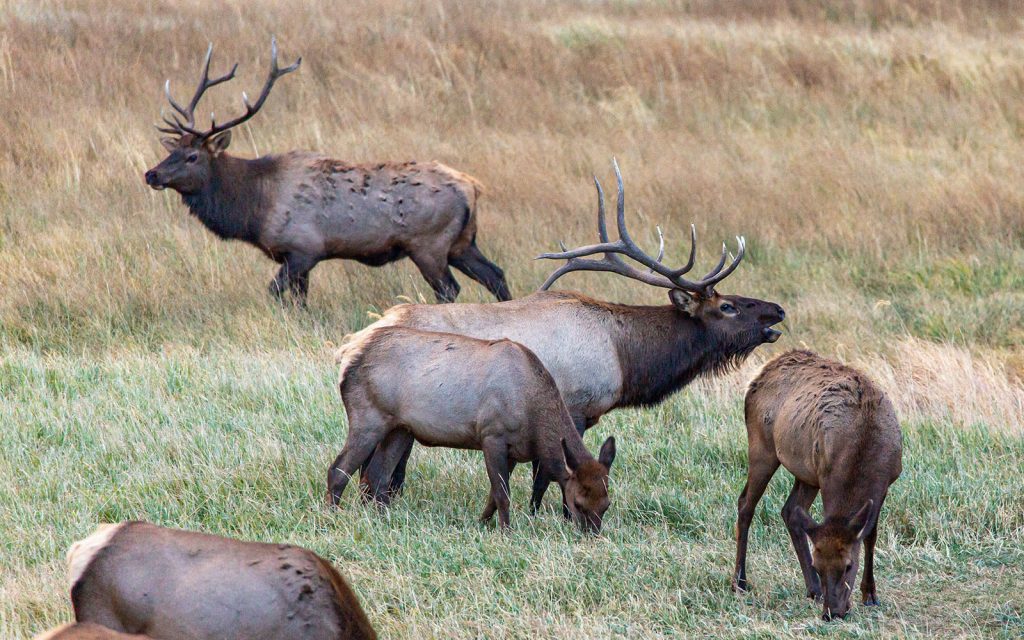
During the peak-rut, when the big bulls are with the herds and focused on breeding, it can be tough to pull those bulls away, especially if there is a cow in estrous in the herd. Herd bulls get tunnel vision during this time, and they are completely occupied with breeding. The younger bulls, however, are pretty desperate at this point, and aside from getting beaten up multiple times over the past couple of weeks, they are still pretty hopeful and will often come in to calls.
Then, as the rut winds down, you might find the big bulls very vocally trying to keep the herd together, but they will be very unlikely to come in to calls. The younger bulls will be pretty timid as well, so calling becomes mostly a resource for locating bulls once again.
With this synopsis of how elk might be responding to calls at different times throughout the rut, I want to point out one important note: I can explain to you all of the calling tactics in the world, but simply knowing what tactics to apply won’t do you nearly as much good as knowing why to apply them. You need to consider what is going on in the elk’s mind as you set up to call to him. Is he an irritable herd bull that has no cows? If he has no cows, he probably isn’t going to be too interested in breeding quite yet. If he was, he would probably have cows. But, he might be very aggressive toward another intruding bull getting too close to his comfort zone. Is there a lot of fresh elk sign, but no bugling activity yet? You might try more of a “blind-calling” or herd-talk setup and hope to bring in a lonely, silent young bull. If there are multiple herd bulls in close proximity and the peak rut hasn’t kicked in, the bulls are going to have fighting on their minds. Hopefully, you get my point. Understanding the dynamics of the elk from day to day is going enable you to employ the best calling tactic for you on that particular day.
With that being said, there are several calling tactics aside from my Challenge Sequence that I have used regularly and had good luck with. Sometimes, I’ll switch up tactics during a calling sequence if what I’m trying isn’t working. Other times, I’ll shift completely to a new tactic if I find the elk are responding better to it than what I had been trying previously. Again, consider how each of these tactics might be interpreted by the elk, and consider what emotions you will need to add to the calling to communicate what you need to communicate to bring the elk in.
THE SLINGSHOT
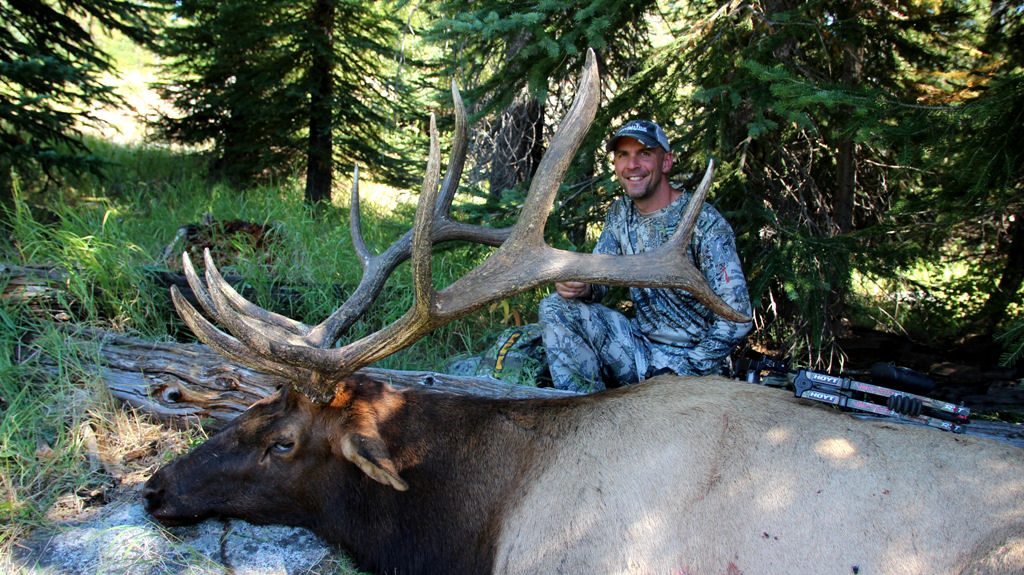
The Slingshot is probably my favorite calling tactic that I mix in with my Challenge Sequence, and it has proven to be very effective on bigger herd bulls that can be difficult to influence with just a standard calling setup.
I’ve always felt that getting close to a bull is the key to getting him fired up and committed to coming in to the calls. However, that is not always an easy feat, especially when you have to get the caller in close enough to push the bull’s buttons, but still stay back far enough to pull the bull in to a shooter.
A few years ago, my hunting partner and I were chasing a big herd bull up a steep Idaho mountainside. The bull was following his cows as they made their way back to the bedding area, and there was no amount of coaxing or insulting we could throw his way to convince him to stop and fight. He was fired up, and our bugling matches were quite intense, but we just couldn’t get inside 150 yards and the bull just wouldn’t turn and come to us.
I decided to try to slip in quietly, but with the calls still 150+ yards away from the bull, he just wouldn’t commit, and kept moving up the mountain. Finally, I was able to silently slip within 100 yards of the bull and caught a glimpse of him as he pushed a cow up the ridge in front of me. My hunting partner bugled from 80 yards below me, and the bull answered. More out of desperation than pre-calculated strategy, I grabbed my bugle tube and screamed a challenge at the bull. I was close to him, and he wasn’t happy.
As the herd bull left his cow and came storming down the hillside to face the challenge, my bugle tube hit the dirt and the caller was able to take back over. My challenge from inside the “Red Zone” though, had tripped the trigger and released more testosterone than the bull than could control. Filled with rage and ignoring his instincts, the bull was on a crash course to crush the threat. As the bull came down the hillside, the calling from my hunting partner 50-60 yards behind me captured the bull’s attention and pulled him right past me for a perfect 30-yard broadside shot.
Here is the video from that hunt demonstrating the Slingshot Method in action:
Typically, it isn’t advisable to have the shooter do any calling. However, sometimes it’s nearly impossible to get the designated caller close enough to the bull to be effective. With the Slingshot, the shooter gets close to the bull and fires off a short-range challenge. Once the bull commits, the caller takes back over on the calling from 50-60 yards behind. Or, the caller can come up to the shooter’s setup and challenge the bull, and then drop back to coax the bull through the shooter’s setup from a short distance behind. I prefer the first option as it doesn’t run the risk of the caller being spotted as they move back out of the setup. Plus, if I am the shooter, it just gives me another excuse to use my calls!
I’ve found this strategy to be very effective on mature herd bulls, especially during the peak of the rut when it can be hard to pull their attention away from their cows.
RETREAT
Another variation of the Slingshot is what I call the Retreat. The Retreat consists of the caller moving up and calling from as close to the bull as possible (in the shooter’s setup), and then slipping back 60 yards or so to continue calling. This is often a less aggressive sequence that works great on a bull that “wants” to come in, but is just afraid to come inside that last 100 yards.
If you’ve applied pressure to the bull, and you’re able to stay within 100-150 yards of him but not bring him in, this can be a great tactic to try. I captured the effectiveness of the Retreat tactic on a hunt where there were multiple bulls trying to control multiple herds of cows in very close proximity. It was later in the season (early October), and the elk very extremely vocal, but not very cooperative with my calling. There was a large herd bull about 150 yards up the ridge from me, and what sounded like a younger bull 150 yards to my left. Both bulls had cows, and both bulls were very vocal and fired up, but neither bull would take a step in my direction. The open pinion/juniper terrain combined with the noisy, rocky ground, made it nearly impossible for me to slip in any closer.
Finally, the herd bull moved over the ridge to bed with his cows, and left me with no way to approach him without being winded. I decided to try to call in the younger sounding bull to my left. Over the next 30 minutes, I applied every tactic I could think of to break that bull loose and bring him in. My buddy was there filming, and we captured some great audio clips. Unfortunately, we captured more than a couple video clips of dark legs and an antler tip or two all morning. We moved to inside 100 yards of the bull, and could catch glimpses of a couple cows he was desperately afraid of losing, which explained why he was vocal but not coming in to my aggressive challenges.
I motioned for John to stay right where he was with the camera, in a perfect shooting lane, and I would drop back 40 yards to call and rake a tree. If my intuition played out correctly, my Retreat would pull the bull right into that shooting lane, but still allow the bull to feel like he was maintaining a safe distance away from the challenger. Keep in mind, we had been calling to this bull from inside 150 yards for over an hour at this point, and he had not made an advance in our direction even once. Less than 60 seconds after I Retreated, the bull was standing in the shooting lane where John was filming from, and stood there for over 2 minutes, raking and bugling in front of the camera. Had there been a caller and a shooter in this setup, using the Retreat tactic would have resulted in an easy 15 yard broadside shot.
Check out the calling sequence using the Retreat tactic in the video clip below:
THE TRIANGLE
Late in the morning, on the first day of our early-season archery elk hunt in 2004, David Burdette and I found a bull bugling across the steep drainage we were hunting. The bull was responding every 20 minutes or so with half-hearted bugles, typical of a mid-morning, bedded bull early in the season. We sat on the hillside directly across from the bull, and concluded that dropping into the bottom and working up toward the bull with the changing thermals would be risky. Rather than take a chance, we decided to hike down canyon, and move across to the other side to make our way up to the bull’s level. From there, we would wait until the thermals changed again to target him during the evening hunt.
We sat on a ridge adjacent to the bull all afternoon. The bull was quiet throughout the remainder of the day, and around 5:30 p.m., we couldn’t wait any longer. We knew the bull still had to be there, but a couple passive location bugles didn’t prompt a reply. I escalated the aggression a little, and the bull finally responded with the same half-hearted bugle he had been giving us earlier in the day. He was still in the exact same place, and another 30 minutes of sporadic calling prompted just one more reply, with no indication he was heading our way any time soon. This was the only bull we’d heard all day, but the thick huckleberry brush between us and the bull made it impossible for us to slip in any closer. We had to do something to escalate his excitement and convince him to come our way.
David suggested that we split up and call back and forth to each other, hoping the bull would get excited when he heard two other bulls getting worked up. At this point, I thought it was worth a shot. With a good down-thermal, David slipped across the hillside and onto a finger ridge 200 yards or so to my left to initiate our strategy. The bull was 200-250 yards above me, and 250-300 yards above David. We had formed a “triangle”, with the bull at the head of the triangle and David and I at the bottom legs (see the diagram below).
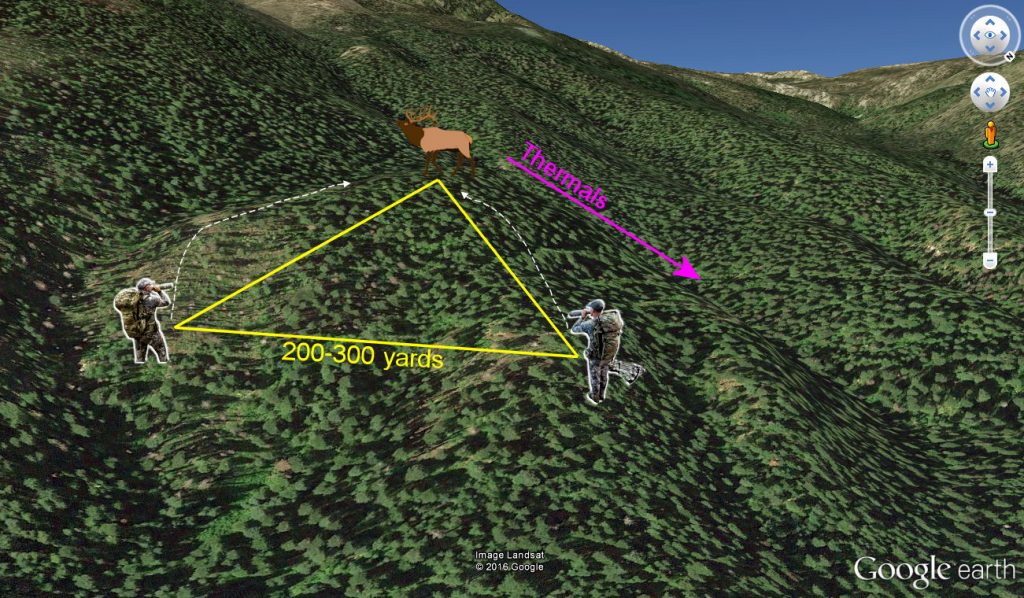
I let out a couple soft cow calls, followed by a non-aggressive bugle, and then waited. Nothing. After a few minutes, I did it again. David waited 2-3 minutes, then let out a soft bugle. Instantly, the bull bugled back. It was the same lazy bugle he’d been giving us all day, but it was his first immediate response. The next time I bugled, David hit me right back with a more aggressive bugle, and the bull again chimed in instantly. David and I continued calling back and forth to each other, purposely ignoring the bulls responses, and I started to slowly make my way up the ridge toward the bull.
I made it to within 150 yards of the bull, and couldn’t go any farther. The thick huckleberry brush gave way to the open ridge the bull was standing on just above me. If I tried going any closer, the bull would be watching for me when I popped up on the ridge. The bull was now bugling every time David and I bugled, sometimes cutting us off before we had a chance to even respond to each other. He wasn’t liking the fact that we were ignoring him, or the fact that we were now uncomfortably close to him. David had been staying back and keeping some distance so as to not put too much pressure on the bull, but with me not able to advance any closer, and daylight fading quickly, David started working his way up the open ridge the bull was on.
At this point, the bull was worked up and had started working his way down the main ridge. We were still treating him as if he didn’t exist, and David and I were calling aggressively back and forth to each other. The bull bugled from the ridgeline just 80-100 yards above me. He was still holding back and somewhat cautious, but his demeanor had definitely changed from just an hour before. I let out a bugle from below the ridge, and David answered from 80 yards to my left. Instantly, the bull answered and I immediately cut him off with an aggressive bugle. David then cut me off, and I watched as the bull’s attitude went from cautious to “I’m going to punish someone!” The bull made a bee-line down the ridge, right past me and straight towards David. The thick brush prevented me from getting a shot as the bull passed by at 40 yards, but the open ridge was a perfect lane for David’s arrow. I heard his bow go off, and before I could scramble up the hill to meet up with him, the bull was lying dead just 60 yards away.
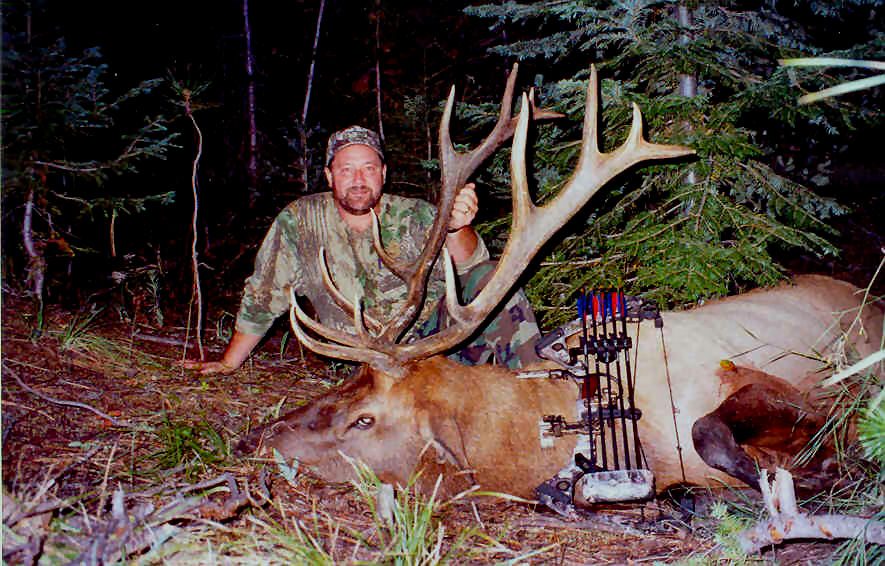
We’ve employed the Triangle tactic many times since, especially on early-season bulls that are timid and unresponsive, or on late season bulls that are talking but not overly interested in coming in to calls. We get the wind in our favor and split up (100-150 yards apart) to form a triangle with the bull. Then, we simply call back and forth to each other as we work our way up the “legs” of the triangle, increasing the intensity of our calling as we get closer.
MIMICKING THE BULL
Another calling tactic that has proven to be effective is to simply mimic the bull. Again, move in as close as possible and set up in a good location. Similar to the Challenge Sequence, I start out with a few cow calls. Then, when the bull responds, I follow up with the exact bugle he just made. If it’s a lazy, bedded bugle, I give one of my own. If it’s chuckles, I chuckle. If it’s a challenge bugle, I challenge him back.
This tactic often takes a little bit of time to convince the bull you are mimicking him, but once he realizes he is being mocked, his patience wears thin and his attitude will often change quickly. It often feels like the bull gets frustrated with you mocking him, and finally comes in to put an end to the ridiculing. This can be a very effective tactic for calling in a bull that previously wouldn’t budge.

HYBRID CALLING
This calling tactic was derived out my inability to sit still. Seriously. I have very limited patience, as you’ve probably already concluded from the previous 8 Modules. If things aren’t progressing as I think they should be, I often push the envelope and try to make something happen, rather than waiting patiently for things to develop on their own. I’m sure I have probably blown more setups because of my lack of patience than I would like to admit, but I will justify my impatience by saying that I have probably made things happen many times when they likely wouldn’t have worked out otherwise.
When it comes to the Hybrid calling tactic, It starts out the same as any calling sequence with a caller back behind a shooter. But rather than trying to call the bull in to a “static” setup, the shooter becomes a spot and stalk hunter, and the caller uses calls simply to keep the bull vocal so the shooter can keep tabs on the bull’s exact location as he moves in.
In this scenario, communication between the caller and the shooter becomes more important. You don’t want the caller to get so far behind the action that the elk goes quiet, but you also don’t want the caller to get so close that they push the elk away. Additionally, if the elk is quiet – but still in the same location – you don’t want the caller to push ahead and bump the bull just as the shooter is making his final stalk for a shot.
With the Hybrid calling tactic, the shooter needs to consider everything they would consider in a static setup. The only difference is now the setup is dynamic, and continually changing. The shooter still maintains complete silence, and is always considering the elk’s senses. It is vital to move at the appropriate times and not make any noise to alert the bull to your presence. Wind is also vital. Another feature that is important to implement is moving in towards the bull from an angle (not in direct line from the caller to the bull). If the bull - or his cows - are watching for the bull that is calling to them from behind, they will be more likely to see or hear you as you approach. If you are able to get off to the side and move in at an angle, you will be less likely to be detected.
I really like using the Hybrid tactic during the peak of the rut when it can be difficult to bring a herd bull in to the calls. They are often very vocal, which makes it nice for keeping tabs on them, but they aren’t usually very easy to pull away from the cows. With a caller keeping the bull talking, and a shooter slipping silently closer to the bull, watching for cows that might thwart the stalk, it is often possible to stalk in close enough for a shot, or to setup in a lane where the bull might chase a cow through.
BUMP AND CHARGE
Speaking of the ever-watching eyes and ears of the herd, what do you do if you bump the cows? Several years ago, we were following a handful of bulls up a canyon as they made their way to their bedding areas. We had called in a couple of bulls already that morning, but hadn't been able to get a shot. One of the bulls was a nice 6X7, so we focused on following him up the mountain and kind of lost track of where the other elk were. Unaware, we ended up right above another herd as they were making their way up the canyon. Unfortunately, the wind was still blowing down, and the cows that were directly below us caught our wind and began crashing down the hill.
The herd bull, unsure what had happened, but obviously concerned that his cows were crashing away from him, bugled in confusion. I immediately cut him off with a challenge, to make him think another bull had slipped in and was harassing his cows.
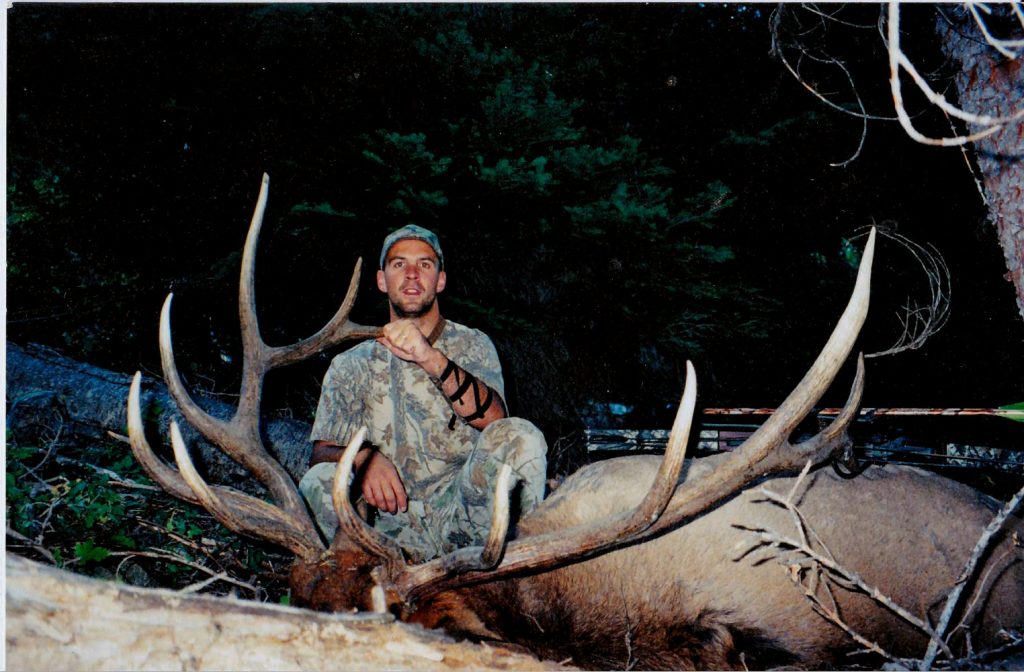
I barely had time to get an arrow on the string as the herd bull came barreling up the hillside to me. I drew and shot, and we stood there in disbelief at how quickly everything had just transpired.
The Bump and Charge tactic can be a great way to recover from a situation where you bump a herd bull’s cows, or get detected by one of their watchful eyes. Oftentimes, if I get busted and the cows haven’t started crashing away – or even if they are already crashing away - I will run right at them and bugle a challenge, hoping that the chaos that ensues will convince the bull that another challenger has come in and tried to steal his cows.
Additionally, if you are able to get in between a bull and his cows, take advantage of the situation. A bull will not tolerate another bull moving in between him and his cows, and it really doesn’t matter what kind of a bugle you make. Just bugle and draw your bow! If you want to see this in action on a more recent hunt, here is video of a great call-in from the 2019 Destination Elk video series:
THE SILENT TREATMENT
You know, as I look back through my calling tactics, I really hope the tactics I use don’t leave a lasting impression upon you of who I really am. I use emotion to cause fights, I mimic bulls to annoy them to come in, and now I mention using a Silent Treatment? Honestly, I only use these tactics for elk hunting, and they aren’t a part of my actual habits outside of elk hunting. I think my wife would agree, right sweetheart? 🙂
But, yeah, the Silent Treatment. It works by making the bull curious. If I am in a setup where I have exhausted every tactic I can think of on a timid, highly-pressured bull, I might just go quiet and quit calling for 15-20 minutes. Again, this goes against my lack of patience, but late in the morning when I need a snack or I’m OK with taking a short break, it can work.
There have been several times when a bull goes quiet for 10-15 minutes, which makes me think the gig is up. So, we take off our packs and sit there quietly eating some trail mix or re-lacing our boots, only to have the bull come sneaking in on our downwind side several minutes later. Younger, more-timid bulls are probably more apt to come in this way. They were afraid to come in to the calling – and even afraid to do too much calling of their own – but once things quiet down, their curiosity gets the best of them and they just have to come in and see if you’re still there. This tactic has also worked good in areas where there are a lot of predators and the elk are often far less vocal and more wary to begin with.
Be sure to set up downwind of where you were calling from, and listen intently for any sounds that might indicate an elk is approaching silently. Often, you won’t hear a thing, and you’ll look up from a bite of a Snickers bar to see a bull staring at you from 30 yards away.
SUMMARY
Ultimately, there are multiple tactics that can work to call in an elk. It really comes down to what you are confident in, and your style of hunting/calling. At the end of the day though, you have to give an elk a reason to come in to your calls. I’ve found that they respond to emotion, so I have to figure out what they’re thinking, and then use my calls to trigger an emotional response from them. Fighting, breeding, curiosity – whatever the emotion is, I have to play to that emotion with my calls.
Again, learning what calls to make in a certain situation can be helpful. However, I think it’s far more beneficial to learn why you should make a certain call. This will enable you to adjust and adapt in any situation, and find a tactic that will work when other tactics aren’t working.
I’ve talked to literally thousands of elk hunters about elk calling over the past several years. I would say a majority of those elk hunters don’t feel calling is effective, and are somewhat skeptical when I talk about how much I rely on my calls. And I would agree that using calls can be frustrating, especially if you are blindly going out and making noise, hoping an elk will respond and come in. If you apply some basic psychology, however, and use calls to elicit a reaction from the elk, calling elk can be one of the most incredibly satisfying, exhilarating, and addictive experiences imaginable.
Practice with your calls to gain the confidence you need to use the calls effectively. Keep it simple. You really only need to be able to make 3-4 calls, period. Before you call, get close to the elk. Use the calls to trigger an emotional response from the elk. Then, draw your bow!
OK, maybe it’s not always quite that easy. But it really isn’t difficult. However, even the best elk callers in the world have bad days and get frustrated because the elk aren’t cooperating. It’s important to not get stuck in a rut, both in the area you are hunting and in the tactics you are using. Perseverance will often overcome challenging situations, so don’t give in. At the same time though, don’t continue beating a dead horse. If something simply isn’t working, learn to recognize when it’s time to push on and when it’s time to switch it up.
Sometimes, a detailed explanation just isn't enough...which is why I've created several videos illustrating many of these tactics and strategies that will help you get close to rutting bull elk.
Click ‘Next Chapter’ Below to Continue to Chapter 4: Breaking Down Actual Calling Scenarios





